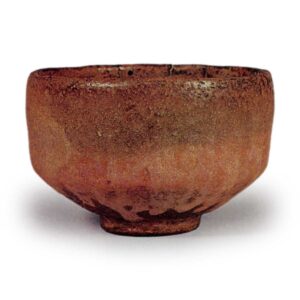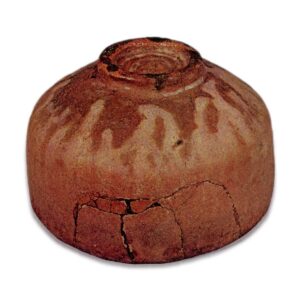

Height 8.0cm, mouth diameter 11.4cm, base diameter 4.9cm
On the front of the lid of the inner box, there is an inscription by Ryosa Kohitsu I, who died in the second year of the Kanbun Era at the age of 91, which reads, “Tea bowl with a design of Rikyu’s master in the shape of a single character. The words “Chojiro ware red tea bowl” on the front of the outer box lid is attributed to Soso Soshitsu, and “Chojiro ware red tea bowl, possession of Rikyu, with one character stamped Fushinan (haseki) Sosho (haseki)” is written on the back of the lid by Suiryusai Sosa and Mahaku Sosho. The inscription “Ichimonji” was handed down from Rikyu to Muneyoshi, then from Sotan to Ryosa Kohitsu I, then to Muneyoshi Kagiya, Gobei Sanami, and Hikosaemon Yamada of Kuwana, and finally to Rogin Toda in 1894, who requested it from the Yamada family, and to Seigai Inoue and Nunoo Masuda, as well as to Ryoosa, as noted by Ryosa. The inscription “ichimonji” is, of course, due to the fact that Rikyu wrote the character for “ichi” and a seal in lacquer on the center of the forehead of the bowl, as noted by Ryosa. The “ichi” character is still faintly visible, but Rikyu’s seal has completely fallen off. However, the glaze has a glossy finish only on the part where the lacquer had adhered to the surface, so the shape of the seal can be recognized when observed in detail. It is not clear why Rikyu wrote the character “ichi” and the seal in lacquer on the prospective of the bowl, but since Ryosa wrote that there is one character and the seal, it must be Rikyu’s own handwriting, and we would like to wait for further investigation as to why such a thing was done.
The appearance of the tea bowl has a randomness and a grandeur, as if Rikyu liked it, and we can feel the seriousness of the bowl as if it was faithfully made according to the kirigata (cut shape). The glaze seems to have been applied quite thickly, but it has changed to a white, chased skin, perhaps due to a low degree of fire. There are several white yuzu nadare (yuzu nadare) flowing from the body to the base, red polychrome clay peeking out from the tatami mats of the round base, five marks remain, and the whorl helmet width is carved low within the base. There are cracks around the base, and one side of the body is heavily damaged. It is similar to “Mokumori,” one of the seven types of Rikyu ceramics, of which only the remaining pieces remain, and may be considered a typical example of Rikyu’s taste. Since “Mokumori” was used in Tensho 14, this piece must have been made around that time. This is one of the seven types of “Chojiro” and other types of “Mokumori.



